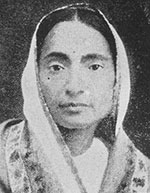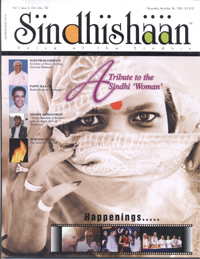![]()
Weaker Sex ? - No Way !
by Kirat Babani

Leading from the Front in the Freedom Struggle of India
Sindh from times immemorial had remained a
free independent and sovereign country till the
Arabs invaded Sindh and defeated the last king Raja Daher Sen and took it over (711 AD). Arabs ruled for over three hundred years (711-1026). Next eight hundred years different tribes and dynasties reigned over Sindh. Thus over a thousand years rule of those, who swore by Islamic faith, influenced the Vedic Sindhi society. During this period status of Sindhi woman was dwarfed; equality was eroded, dignity pushed back, and freedom vastly curtailed, so much so, that she was confined to the four walls of home and was allowed to move out of the house only under the protective cover of a male member of the family and that too, fully covered with a Chaddar from top to toe, leaving openings for the eyes and the nostrils to see and to breathe.
Sindhi society had been compelled to adapt to the very conservative tribal ways of life and adhere to most regressive system of values and behaviours. Teen aged girls were given away in marriage, widow marriage was unthinkable, blame-worthy and sinful. Many such coercive inhibitions were rampant.
It is only after the advent of the British rule in Sindh (1843) that a whiff of new and fresh air blew in the dreary social landscape of Sindh, ushered in by the enlightened western influences. Foreigners introduced many worthwhile reforms to bring change in the mindset of the natives and brought them to the threshold of new awakening. Sindhi language was recognised for imparting education. To that end, Sindhi script was standardised to facilitate instructions in the mother tongue, along with teaching of English language, opening of schools was encouraged. Most significant fact was drawing of women in the vortex of social transformation.
Reformist movements started in the last quarter of 19th century from Bengal. The great reformist leader of India Raja Ram Mohan Roy, founded Brahmoo Samaj, which found a good hunting ground in Bombay for his radical thoughts. A branch was established in Karachi in 1882, which became harbinger of new wave. Soon Girls’ schools were opened in Hyderabad and other centres of Sindh. Great sons of Sindh such as Kauromal Chandanmal, Dayaram Gidumal, Sadhu Hiranand Showkiram, Sadhu Navalrai Advani, Principal S.C. Shahani and others came in the forefront of the radical change in the Sindhi Society.
Sadhu Hiranand was the first Sindhi, who set a rare example by taking his two daughters in Bankepur (Bengal) for higher education to encourage women education. But sadly he expired on the way back home and the ladies also returned. But such a bold action inspired many homes and caught the imagination of advanced sector of the Sindhi community.
Side-by-side another development was taking place on the horizon of India. Foundation stone of the Indian National Congress (INC) was laid at Bombay in the year 1885 with the help of India’s passionate well wisher Dr. Allan O. Hume. To make the conference representative, important persons from different walks of life and from different regions of the country were invited to participate in the founding ceremony. Two worthy sons of Sindh Dayaram Jethmal and Udharam Mulchand were also invited as delegates to the conference.
Initially the object of such platform was to voice the grievances of the native people, seeking redressal through the petitioning of the authorities and getting justice for the people of India. But the movement could not be confined to the prescribed contours for long. Soon it took a radical turn to spearhead a political path, not just petitioning but making forceful demand, for the legitimate aspirations of enslaved people of India. When Mahatma Gandhi arrived on the scene in the twenties of the last century, he further radicalized INC and took it on the road of struggle against the foreign rule. The freedom struggle passed through many phases – from passive disobedience movement to the revolutionary “Quit India’’ call in 1942. The years of fight against the British Raj (1921-1942) will remain a noble chapter of history of our people, in which Sindh’s role remains glorious, particularly that of the Sindhi woman who displayed a heroic role of defiance, courage and bravery against the enslavers.
Mahatama Gandhi gave much importance to women’s participation in the non-violent struggle because he thought they were capable by nature to adhere to non violent conduct. Therefore he insisted as far as possible that the job of picketing should be entrusted to the ladies. In response to Gandhiji’s call for action women came out not in tens, not in hundreds, but in thousands from a region which was considered comparatively to be socially backward. In the words of a poet, “It was a sight for the Gods to stare” – women young and old, married and unmarried, sitting outside the shops of liquor and foreign cloth and goods, spinning Khadi yarn on takli and imploring the customers with folded hands, to desist from purchasing either liquor or foreign cloth and other goods.
But our Sindhi sisters were not content with this passive role of picketing outside the shops. They wanted to do something more aggressive. In this they were inspired by their sisters from outside, like Sarojini Naidu and others to break government laws. They came out of their shells to play a more active role and make contributions to the freedom struggle on higher levels. So the ladies were not only picketeers, but lawbreakers, they were first speakers in the public meetings and also leaders to lead in mass actions.
The most interesting and proud feature of our freedom struggle was the unique development of several couples (husband and wife) working shoulder-to-shoulder, getting arrested and going to prison. Some of them can be enumerated as Hiranand Karamchand and his wife KAMLA, Assudomal Gidwani and his wife GANGABAI, Sewakram Karamchand and his wife SHEELVANTI, Hassomal Issardas and his wife DEVIBAI, Prof. Shamdas Vaswani and his wife SATIBEN, Choithram Valecha and his wife SUNDRIBEN, Metharam Harumal and his wife GANGABEN, Rochiram Thawani and his wife KAMLABEN, Deep Chandera and his wife MOHINI and the list will go on lengthening. Most proud and brave act was that of those ladies who had new born babies in their laps.
 |
 |
 |
||
|
|
Two brave Sindhi women with exemplary behaviour standout as a distinct class by themselves and deserve a special mention in our survey. GANGABAI and LACHMIDEVI from the historical city of Shikarpur in upper Sindh made history, by their courageous actions. The former was the first woman to be arrested and imprisoned in Sindh during 1930 salt Satyagrah. She was awarded one month’s sentence, but it was the beginning of making of history. She was a school teacher. Later on she turned to be a powerful public orator, whose services were sought for throughout the Sindh for spreading the message of spirit of freedom. The case of Lachmidevi is even more daring and inspiring. She was not an educated lady at all but a woman with inner light and strength. A homely woman living within four walls of her home. One wonders from where she got the inspiration and courage to stand up in the court before a magistrate to listen to a harsh sentence of two years rigorous imprisonment and Rs. 500/- fine. Failing which, another six months imprisonment would be added to the term of two years. This was during the start of the 1932 Civil Disobedience movement. She displayed a rare sense of bravery and moral strength. On emerging from the court, replying to the question of an inquisitive bystander, as to her sentence awarded, she non-challantly said, “two and half minutes”. Salute to the great daughter of Sindh.
Ladies from the highly placed aristocratic families too, abandoning their pleasures and easy going carefree life, willingly accepted hardship of Jail life. KIKIBEN Lalwani, sister of great national leader J.B. Kripalani, at one time acted as dictator of the movement. Then there was Kumari SARLA Narsian a double graduate, Principal of a high school at Sukkar, who also resigned her job to join “Quit India” movement and was detained for two years as security prisoner. Another brave lady of Sindh, JETHI Sipahimalani jumped into the movement in 1930 immediately after her graduation. She was very popular in Sindhi Society, and had carved a niche for herself in the political spectrum of Sindh politics. She was twice elected to the Sindh Legislative Assembly unopposed and became deputy speaker of Sindh Legislative Assembly, an honour very few women could boast of.
Apart from the ladies of the elite class, numerous volunteers came from the middle classes, who would walk shoulder to shoulder with men in processions, shouting anti British slogans, little caring about the lathi wielding or gun toting policemen. They defied the law.
One instance of such defiance has been recorded in Sindh’s national history. At one point of time the police raided a women volunteers camp to prevent the proposed picketing at the famous Goverdhandas cloth market, Karachi. They had taken away 30 to 40 lady volunteer to frustrate the action. A message went round and the next morning at the appointed time and place as many as 300 to 400 women volunteers arrived to offer the satyagrah, defying the police orders. The most inspiring aspect of the situation was that, in some cases daughters and sisters of the merchants came to confront their elders. Commenting on the incident the daily Gazette, an Anglo-Indian news paper wrote: “The government appeared to have ceased to function in Karachi on that day. The cloth market was virtually under the control of the satyagrahis”.
Such was the awakening and empowerment of women of Sindh, during the freedom struggle.


